
Ford Madox Brown was a British painter of moral and historical subjects, notable for his distinctively graphic and often Hogarthian version of the Pre-Raphaelite style. Arguably, his most notable painting was Work (1852–1865). Brown spent the latter years of his life painting the twelve works known as The Manchester Murals, depicting Mancunian history, for Manchester Town Hall.

The Pre-Raphaelite Brotherhood was a group of English painters, poets, and art critics, founded in 1848 by William Holman Hunt, John Everett Millais, Dante Gabriel Rossetti, William Michael Rossetti, James Collinson, Frederic George Stephens and Thomas Woolner who formed a seven-member "Brotherhood" partly modelled on the Nazarene movement. The Brotherhood was only ever a loose association and their principles were shared by other artists of the time, including Ford Madox Brown, Arthur Hughes and Marie Spartali Stillman. Later followers of the principles of the Brotherhood included Edward Burne-Jones, William Morris and John William Waterhouse.

Sir Edward Coley Burne-Jones, 1st Baronet, was an English painter and designer associated with the Pre-Raphaelite Brotherhood's style and subject matter.

Birmingham Museum and Art Gallery (BM&AG) is a museum and art gallery in Birmingham, England. It has a collection of international importance covering fine art, ceramics, metalwork, jewellery, natural history, archaeology, ethnography, local history and industrial history.
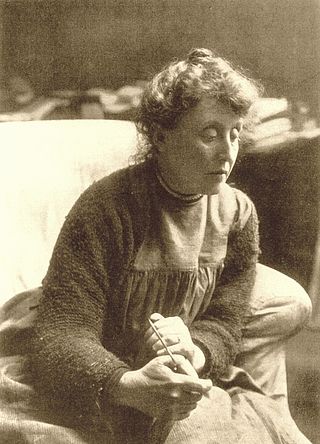
Evelyn De Morgan was an English painter associated early in her career with the later phase of the Pre-Raphaelite Movement, and working in a range of styles including Aestheticism and Symbolism. Her paintings are figural, foregrounding the female body through the use of spiritual, mythological, and allegorical themes. They rely on a range of metaphors to express what several scholars have identified as spiritualist and feminist content. Her later works also dealt with the themes of war from a pacifist perspective, engaging with conflicts such as the Second Boer War and World War I.
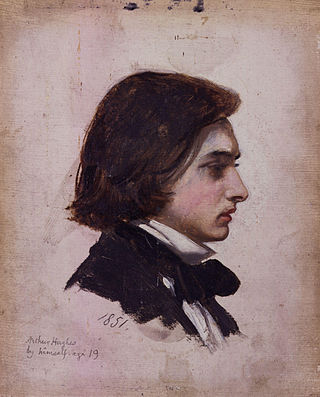
Arthur Hughes was an English painter and illustrator associated with the Pre-Raphaelite Brotherhood.

Fanny Cornforth was an English artist's model, and the mistress and muse of the Pre-Raphaelite painter Dante Gabriel Rossetti. Cornforth performed the duties of housekeeper for Rossetti. In Rossetti's paintings, the figures modelled by Fanny Cornforth are generally rather voluptuous, differing from those of other models such as Alexa Wilding, Jane Morris and Elizabeth Siddal.
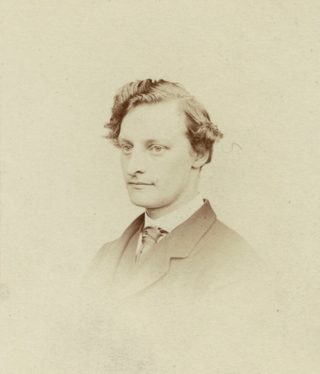
Edward Robert Hughes was a British painter, who primarily worked in watercolours, but also produced a number of oil paintings. He was influenced by his uncle and artist, Arthur Hughes who was associated with the Pre-Raphaelite Brotherhood, and worked closely with one of the Brotherhood's founders, William Holman Hunt.

Anthony Frederick Augustus Sandys, usually known as Frederick Sandys, was a British painter, illustrator, and draughtsman, associated with the Pre-Raphaelites. He was also associated with the Norwich School of painters.

The Last of England is an 1855 oil-on-panel painting by Ford Madox Brown depicting two emigrants leaving England to start a new life in Australia with their baby. The painting has an oval format and is in the Birmingham Museum and Art Gallery.
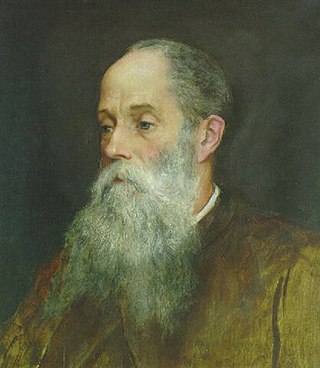
John Roddam Spencer Stanhope was an English artist associated with Edward Burne-Jones and George Frederic Watts and often regarded as a second-wave pre-Raphaelite. His work is also studied within the context of Aestheticism and British Symbolism. As a painter, Stanhope worked in oil, watercolor, fresco, tempera, and mixed media. His subject matter was mythological, allegorical, biblical, and contemporary. Stanhope was born in Cawthorne, near Barnsley, Yorkshire, England, and died in Florence, Italy. He was the uncle and teacher of the painter Evelyn De Morgan and encouraged then unknown local artist Abel Hold to exhibit at the Royal Academy, which he did 16 times.

The Magic Circle is an 1886 oil painting in the Pre-Raphaelite style by John William Waterhouse. Two copies of the painting were produced. The two paintings and a study depict a witch or sorceress using a wand to draw a fiery magic circle on the Earth to create a ritual space for her ceremonial magic. As was common in the period, Waterhouse repeated his subject on a smaller scale, probably at the request of a collector.

Mary Magdalene is a Pre-Raphaelite oil-on-panel painting by the British artist Frederick Sandys, executed in 1858–1860. Mary Magdalene was the only figure from the Bible that Sandys ever painted. Having sharp features reminiscent of Lizzie Siddal, Mary is depicted in front of a patterned forest-green damask. She holds an alabaster ointment cup, a traditional attribute which associates her with the unnamed sinful woman who anointed Jesus' feet in Luke 7:37. Like other Pre-Raphaelite painters, Frederick Sandys gave Magdalene a sensual look.
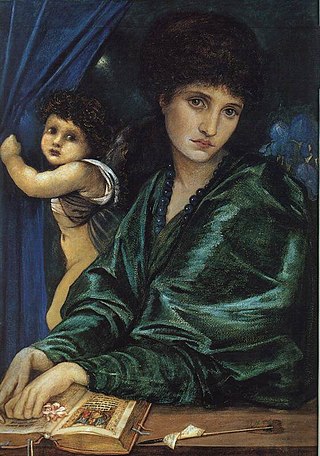
Maria Zambaco, born Marie Terpsithea Cassavetti, was a British artist's model of Greek descent, favoured by the Pre-Raphaelites. She was also a sculptor.

Emma Sandys was a British Pre-Raphaelite painter.

Ecce Ancilla Domini, or The Annunciation, is an oil painting by the English artist Dante Gabriel Rossetti, first painted in 1850 and now in Tate Britain in London. The Latin title is a quotation from the Vulgate text of the first chapter of the Gospel of Saint Luke, describing the Annunciation, where Mary accepts the message brought to her by the Angel Gabriel that she would give birth to a child (Jesus) by God.

Proserpine is an oil painting on canvas by English artist and poet Dante Gabriel Rossetti, painted in 1874 and now in Tate Britain. Rossetti began work on the painting in 1871 and painted at least eight separate versions, the last only completed in 1882, the year of his death. Early versions were promised to Charles Augustus Howell. The painting discussed in this article is the so-called seventh version commissioned by Frederick Richards Leyland, now at the Tate Gallery, with the very similar final version now at the Birmingham Museum and Art Gallery.

Fanny Eaton was a Jamaican-born artist's model and domestic worker. She is best known as a model for the Pre-Raphaelite Brotherhood and their circle in England between 1859 and 1867. Her public debut was in Simeon Solomon's painting The Mother of Moses, which was exhibited at the Royal Academy in 1860. She was also featured in works by Dante Gabriel Rossetti, John Everett Millais, Joanna Mary Boyce, Rebecca Solomon, and others.

















